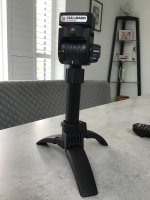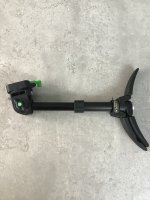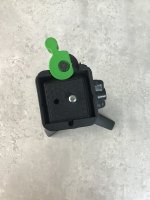As previously mentioned, I bought an STC to replace my CTC 30x75 drawtube.
To reiterate context, I'm an infrequent scope user but when I do take one out then portability, together with a complete lack of clutter, is important to me. I just can't be bothered with big / heavy rigs.
For a few years I'd been very happy with the CTC, it proved extremely practical in the field and rarely did I find myself in a position where I needed to deploy it but couldn't find some-or-other rest, even if that rest turned out to be me myself lying back in some form of inelegant-crossed-legs fashion.
Though I never suffered any moisture ingress or other contamination issues with the CTC, I was attracted to the STC because of the intrinsically increased robustness and reliability. It also appealed because it's incredibly compact and very unobtrusive when shouldered on its strap.
So, after about a week of using the STC in a few different habitats and circumstances; including use from car, pushbike, camper, bird hides and just generally bumbling around: I'm a little disappointed to report that this is probably not the best purchase I've ever made.
For a start, the scope is proving more problematic to place on ad-hoc rests than my CTC was. I've discovered the diminutive form works against it somewhat, as it offers less surface area to perch upon and fewer stabilising 'triangulation' opportunities.
There's a certain paradox, too, in the fact that I found using the scope without the (intuitively useful) half-shell actually often makes the combined operation of ad-hoc rest placement and focussing easier. In a nutshell, at any given time the half-shell rarely seems to be where I need it to be, and indeed mostly where I'd prefer it wasn't. Simplistically, with the STC, spontaneous field use is generally altogether more 'fumbly' and just not as untroubled as it was with the CTC.
If using without any rests, straightforward hand-holding at ~17x is plausible for a quick ID, but again, I find hand-holding and simultaneously focussing quicker and easier without the half-shell in place.
Portability, at least, is excellent - but I'd have preferred to have seen a third tethering point dedicated to the eyepiece cover. Currently, when the strap is attached, the eyepiece cover needs to be piggy-backed to one of the (two) shoulder strap tethering points, or attached to the shoulder strap itself. Either way leads to some tangling and frustration.
Perhaps because of the impromptu rests I utilise, and the jaunty viewing angles these sometimes inevitably mean, I'm also finding eye placement more troublesome than with the CTC. I find myself screwing the eyecup in and out quite a bit to compensate for imperfect viewing angles: something I'd rather not have to faff about doing whilst trying to quickly acquire a subject. It's possible that anatomy plays a role here but I just don't find it anywhere near as easy to quickly and reliably achieve correct eye placement as I did with the CTC. Of course, if settled in a hide or similar that affords a consistent resting opportunity, this particular frustration isn't such a factor.
Optically, well, I'm surprised and disappointed to report that I'm not massively impressed. Performance is, well… OK, but I'm not sure the optical compromises I'm perceiving are worth the undoubted advantages in robustness, storage and portability.
In low light conditions in particular, especially if also set at a higher magnification, I find that image quality suffers significantly to the point where if trying to observe even quite distant subjects, I can often make out the same level of detail using my NL 12x42 courtesy of better resolution, contrast and brightness.
Even in good light, I'm still not massively impressed with image quality at higher magnifications, with resolution in particular being quite disappointing. That said, in decent light, image quality using anything up to about 25-30x is pretty good.
Regarding other optical qualities: in very testing circumstances (dark twigs against open sky) I can see some colour fringing, though this is only visible towards the very edges and is not troublesome (to me) in 'normal' use. In less testing circumstances, 'sharpness' right to the edges is very good with no obviously distracting field curvature or other 'edge' aberrations.
I accept that it would be wholly unrealistic to imagine the ATC/STC would perform like its high-end, large-objective cousins, but even with limited expectations it's not really wowed me.
In summary, it certainly isn't a bad piece of kit but I can't help thinking that a slightly increased objective lens diameter and a fixed magnification eyepiece of ~25x would have resulted in an optically superior and improved all-round product.
I acknowledge using this scope on a good, stable tripod would perhaps result in a different impression but using it in the way I prefer to use scopes, and the way the manufacturer suggests is entirely appropriate, I'm afraid my feelings are currently quite lukewarm.
It does the job but isn't bringing me much in the way of joy.












